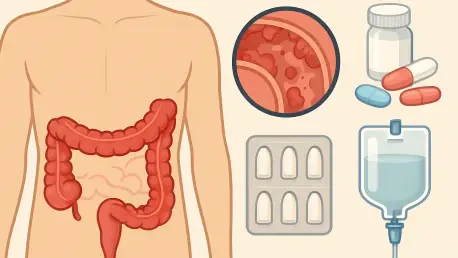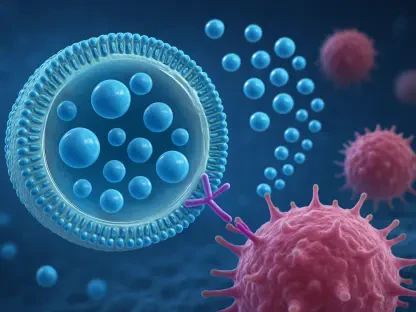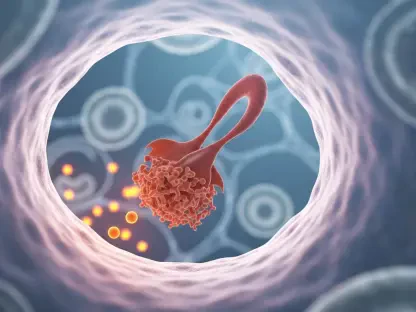Ulcerative colitis (UC), a chronic inflammatory bowel disease, affects millions of individuals worldwide, presenting as persistent inflammation in the colon and rectum, often resulting in severe discomfort and a diminished quality of life for those affected. For patients dealing with moderate to severe forms of this condition, anti-TNF-α therapies, such as infliximab, have become vital treatments aimed at reducing inflammation by targeting a key cytokine. Yet, the effectiveness of these therapies remains frustratingly inconsistent—while some patients experience significant relief, others see no improvement or gradually lose response over time. This disparity in outcomes has long puzzled the medical community, prompting deeper investigation into the underlying immune mechanisms. A recent groundbreaking study utilizing single-cell RNA sequencing has highlighted a specific immune cell subset, conventional dendritic cells type 3 (cDC3s), as a critical factor influencing treatment responses. This article delves into the intricate role of cDC3s in UC and explores the implications for future therapeutic strategies.
Unraveling the Role of cDC3s in Immune Dysregulation
Conventional dendritic cells type 3, known as cDC3s, are essential components of the immune system, serving as intermediaries between innate and adaptive immunity through antigen presentation and T-cell activation. In the context of ulcerative colitis, however, their function appears to take a harmful turn. Research using advanced sequencing techniques has revealed that in patients who show poor responses to anti-TNF-α therapy, cDC3s exhibit distinct molecular signatures characterized by elevated levels of inflammatory cytokines. These cytokines perpetuate inflammation within the gut, directly undermining the intended anti-inflammatory effects of the treatment. This finding provides a crucial piece of the puzzle in understanding why certain individuals struggle with persistent symptoms despite being on what should be an effective medication regimen. It suggests that cDC3s are not merely passive players but active contributors to the disease’s resistance to standard care.
Beyond producing inflammatory signals, cDC3s also engage in significant interactions with effector T-cells, worsening harmful immune responses that intensify the severity of ulcerative colitis in non-responders. This dynamic creates a self-sustaining loop of inflammation, where cDC3s amplify T-cell activity, which in turn fuels further immune activation in the gut lining. The precision of single-cell RNA sequencing has been instrumental in uncovering these cellular interactions, offering a detailed perspective that older, bulk sequencing methods could not provide. Unlike traditional approaches that average out gene expression across cell populations, this technology highlights the unique behavior of individual cells, painting a clearer picture of how cDC3s drive treatment resistance. Such insights underscore the complexity of immune dysregulation in UC and point to specific cellular mechanisms that could be targeted to break this inflammatory cycle.
Addressing Variability in Treatment Responses
The variability in how patients respond to anti-TNF-α therapies represents one of the most significant challenges in managing ulcerative colitis effectively. While these drugs have proven transformative for some, delivering substantial symptom relief and improved quality of life, a considerable number of patients either fail to respond from the outset or experience diminishing benefits over time. The recent identification of cDC3s as a contributing factor to this inconsistency offers a new lens through which to view treatment outcomes. It suggests that differences in immune cell behavior, particularly the pro-inflammatory tendencies of cDC3s, play a critical role in determining whether a patient will benefit from these therapies. This discovery moves the conversation beyond generalized treatment protocols toward a more nuanced understanding of individual immune profiles and their impact on therapeutic success.
Digging deeper into this issue, the distinct transcriptional profiles of cDC3s in non-responders indicate that not all immune responses are created equal, even among patients with the same diagnosis. This variability raises critical questions about why cDC3s behave differently across individuals and how factors such as genetics or environmental influences might shape their activity. For clinicians, this means that a one-size-fits-all approach to UC management may no longer suffice. Instead, recognizing the role of specific immune cells like cDC3s could lead to more informed decisions about which patients are likely to respond to anti-TNF-α agents. By addressing these cellular differences, the medical field can begin to bridge the gap between those who benefit from current treatments and those who are left searching for alternative solutions to manage their chronic condition.
Pioneering Personalized Approaches in UC Management
The insights gained from studying cDC3s pave the way for a transformative shift toward personalized medicine in the treatment of ulcerative colitis. By analyzing the immune characteristics of individual patients, particularly the activity and molecular signatures of cDC3s, healthcare providers could potentially predict who will respond favorably to anti-TNF-α therapies and who might require alternative interventions. Such an approach would minimize the trial-and-error process that many patients currently endure, reducing exposure to ineffective drugs and their associated side effects. This tailored strategy aligns with broader trends in medicine, where treatments are increasingly customized to match the unique biological makeup of each patient, promising a future where UC management is both more effective and less burdensome.
Furthermore, the specific focus on cDC3s suggests the possibility of developing novel therapies aimed at modulating their inflammatory behavior without compromising the broader immune system. If researchers can identify and target the pathways that drive cDC3s to produce excessive cytokines or overstimulate T-cells, new drugs could be designed to interrupt these harmful processes. This approach would not only enhance the efficacy of existing treatments like anti-TNF-α therapies but also offer hope to those who currently have limited options. The move toward precision medicine in UC, fueled by discoveries about cells like cDC3s, represents a significant step forward in addressing the unmet needs of patients. It emphasizes the importance of understanding immune heterogeneity as a foundation for creating more targeted and successful therapeutic interventions.
Exploring New Horizons in cDC3 Research
Despite the compelling findings about cDC3s, numerous questions remain unanswered, pointing to the need for continued exploration in this area of ulcerative colitis research. One intriguing avenue is the relationship between cDC3s and the gut microbiome, a complex ecosystem known to influence immune responses in the digestive tract. Could microbial imbalances trigger or exacerbate the pro-inflammatory behavior of cDC3s? Additionally, researchers are eager to investigate whether lifestyle factors, such as diet, or interventions like probiotics could modulate cDC3 activity in conjunction with pharmacological treatments. These inquiries highlight the multifaceted nature of UC and the potential for integrating diverse strategies to address the role of specific immune cells in disease progression.
Another critical focus for future studies is the identification of specific signaling pathways that regulate cDC3 activation and cytokine production in UC patients. Pinpointing these molecular mechanisms could unlock new therapeutic targets, enabling the development of drugs that selectively dampen the harmful effects of cDC3s while preserving their essential protective functions. Moreover, validating these findings across diverse patient populations is essential to ensure that the role of cDC3s is consistent regardless of genetic or environmental differences. As research progresses, the hope is to build a comprehensive understanding of how cDC3s contribute to treatment outcomes, ultimately leading to more robust and adaptable solutions for managing this challenging condition over the coming years.
Implications for Other Inflammatory Conditions
The revelations about cDC3s in ulcerative colitis extend far beyond this single disease, offering valuable lessons for a range of inflammatory and autoimmune conditions. Disorders like Crohn’s disease, rheumatoid arthritis, and psoriasis also involve complex immune dysregulation, where specific cell subsets may play similarly detrimental roles. The application of single-cell RNA sequencing, as demonstrated in the UC study, provides a powerful tool to map immune landscapes in these conditions, potentially identifying shared mechanisms or unique cellular culprits akin to cDC3s. Such cross-disease insights could inspire the development of therapies that target specific immune pathways, enhancing treatment precision across a spectrum of chronic illnesses.
Additionally, the focus on cDC3s underscores the dual nature of dendritic cells as both defenders against pathogens and potential drivers of chronic inflammation when dysregulated. This duality suggests that therapies designed to modulate cDC3 activity in UC might have broader applications, provided they can balance immune suppression with necessary protective responses. As single-cell technologies continue to evolve, their use in dissecting immune responses in various diseases could revolutionize how inflammatory conditions are approached. By fostering a deeper understanding of cellular contributions to disease, this research lays the groundwork for a future where treatments are not only more effective but also adaptable to the unique immune profiles of patients across different medical contexts.
Reflecting on Advances and Next Steps
Looking back, the exploration of cDC3s marked a pivotal moment in understanding why anti-TNF-α therapies yielded mixed results for ulcerative colitis patients. The use of single-cell RNA sequencing illuminated the pro-inflammatory actions of these dendritic cells and their role in amplifying harmful T-cell responses, offering a clear explanation for treatment resistance in some individuals. This research not only deepened the grasp of immune dynamics in UC but also reinforced the value of cutting-edge technologies in revealing hidden cellular mechanisms. Moving forward, the focus should shift to translating these insights into practical solutions, such as developing diagnostic tools to assess cDC3 activity before initiating therapy. Additionally, fostering collaborations between researchers and clinicians will be crucial to test targeted interventions and explore the interplay between cDC3s and factors like the gut microbiome, ensuring that future advancements build on this foundation to deliver lasting improvements in patient care.









